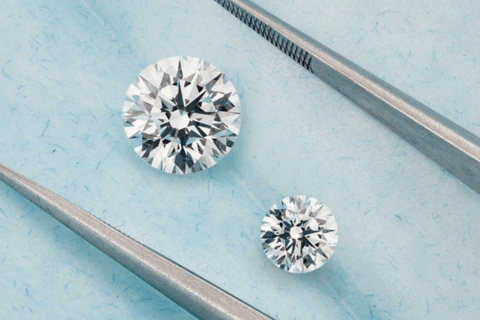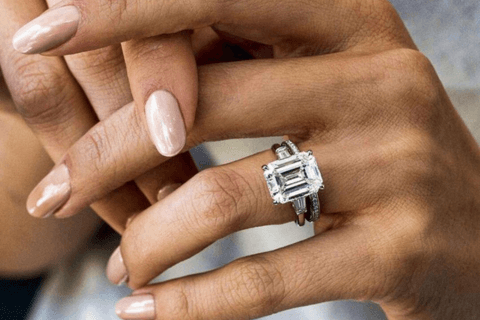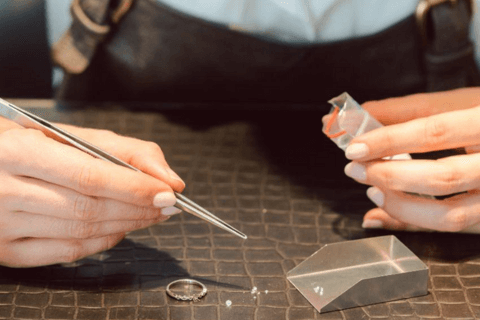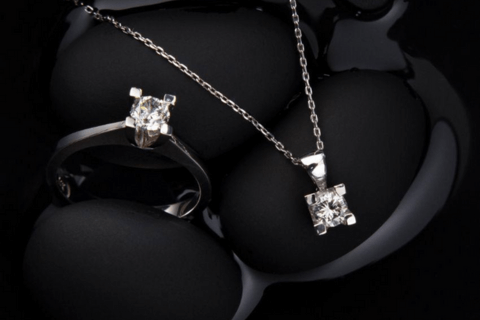Diamonds have been a symbol of love and commitment for centuries, but with the rise of lab-grown diamonds, there’s a new option for couples who want to get engaged without breaking the bank.
Unlike imitation diamonds made from glass or plastic, lab-grown diamonds are real diamonds created in a laboratory using a sophisticated process. This makes them less expensive than traditional diamonds.
Lab-grown diamonds are becoming increasingly popular due to their affordability, stunning beauty, durability, and eco-friendliness, offering several benefits over their mined counterparts.
In this blog post, we’ll explore the top seven reasons why lab-grown diamonds are becoming more popular and why you might want to consider them for your next piece of jewelry.
Let’s dive in!
1. Aesthetically identical to natural diamonds

Lab-grown diamonds are aesthetically identical to natural diamonds. They both have the same sparkle and fire, the same different types of color and clarity.
Not only that, lab-grown diamonds are not a diamond simulant like cubic zirconia or moissanite, as explained by Dr. Sally Magaña, a Gemological Institute of America (GIA) research scientist. Both have the same physical, chemical, and optical properties.
However, one thing does give lab-grown diamonds an edge: they are created in a controlled environment that allows them to have improved clarity and fewer flaws compared to naturally mined diamonds.
Since they are the same physically and chemically, you can’t tell the difference between mined diamonds and lab-created ones with your naked eye.
Only by using specialized equipment and testing are experienced gemologists able to distinguish between a lab-grown diamond from a natural one.
As a final note on their similarity, both lab-grown and natural diamonds are graded similarly on the 4Cs — cut, color, clarity, and carat weight.
This means that the quality grading criteria set by the Gemological Institute of America (GIA) apply to lab-grown and natural diamonds alike, ensuring that one is not better than the other.
You may also like: Should I Get A Lab Grown Diamond For Engagement Ring?
2. Less expensive than mined diamonds

Lab-grown diamonds a great option for those on a budget or for those who want to save money without sacrificing the look and sparkle of a natural diamond.
That’s because lab-grown diamonds are less costly than mined diamonds. In fact, they can cost 30% to 40% less than naturally mined diamonds of the same size and quality.
For example, a 1-carat natural diamond with an SI1 clarity rating may cost $6,100, while a Lab-grown diamond with the same rating would cost about $2,300.
Additionally, you can purchase a 2-carat lab-grown diamond for about the same price as a 1-carat natural diamond.
For a more in-depth analysis of lab-made diamonds’ worth, check out Are Lab-Grown Diamonds a Good Investment?
3. Produced in a much shorter time frame

Lab-grown diamonds can be produced in a much shorter time frame compared to natural diamonds, which take millions of years to form in nature.
According to Sidney Neuhaus, co-founder of Kimaï, it only took five days to grow the diamonds she made for Meghan Markle that caught the world’s attention.
This is because lab-grown diamonds are created under controlled conditions in a laboratory, allowing for a more efficient, scaleable, and speedy production process.
In contrast, natural diamonds require complex geological processes and the right conditions over an extended period of time to form in a natural environment, making them much rarer and more expensive.
Check out some exquisite lab-grown diamond collections in our store.
4. More environmentally friendly
Lab-grown diamonds are often considered to be a more environmentally friendly option than natural diamonds.
This is because natural diamonds are mined through Marine, open-pit, and underground mining.
These processes have a significant negative impact on the environment, including the release of greenhouse gases and damage to local ecosystems. This aside, the cost of maintaining these expansive facilities.
Let’s discuss each briefly.
Mining has a direct negative impact on the earth’s crust.

Impacts the ecosystem negatively
The impact of diamond mining on ecosystems can be devastating, with local water supplies and soil often becoming polluted. For example, hundreds of cattle died in Zimbabwe after drinking water from the Odzi River, which runs downstream from a diamond processing plant. Similar incidents occur in other mining regions Africa’s with limited water supplies forcing locals, livestock, and wildlife to drink contaminated water.Impact the Marine negatively
Concerning Marine diamond mining, this, too, does affect the ocean. Although most of the mined sediment is returned, the process can take two to ten years, and the long-term consequences on the oceans are unknown. In addition, concerns have been raised about the impact of noise, machinery, and light on marine life and the problems caused by pollution and climate change. On the other hand, lab-created diamonds do not require the same disruptive mining techniques, and companies that use renewable energy sources like solar can significantly reduce the industry’s carbon footprint. While the sustainability of lab-grown diamonds depends on the manufacturing process, they are often considered a more environmentally friendly option than natural diamonds. For those looking to buy beautiful and sustainable jewelry, lab-grown diamonds are an excellent choice and demonstrate a consciousness of the planet’s climate and the environmental impact of mining for natural diamonds. Want to make a difference for the planet while still getting a stunning diamond? Shop our collection of eco-friendly lab-grown diamonds and discover the perfect piece of jewelry that reflects your values.5. More ethically responsible
Lab-grown diamonds are considered more ethically responsible than mined diamonds because the latter have often been associated with unethical labor practices. These include using child labor and funding conflicts in war-torn areas through the sale of conflict diamonds also known as blood diamonds.
For this reason, the United States prohibited the sale of blood diamonds in 2003 with the Clean Diamond Trade Act. Also, many countries collaborated through the Kimberley Process to prevent conflict diamonds from being sold.
Despite these safeguards, natural diamonds can be associated with these negative associations, leading to a preference for a more socially responsible engagement ring stone.
In contrast, lab-grown diamonds are created synthetically in a laboratory under controlled conditions by skilled, fairly compensated workers, eliminating the risk of supporting these unethical practices.
The two methods used to create lab-grown diamonds are Chemical Vapor Deposition (CVD) and High-Pressure High-Temperature (HPHT), which do not require any harmful environmental practices or labor exploitation.
As a result, many eco-conscious Millennials and Gen Z individuals who value ethical sourcing prefer lab-grown diamonds for non-traditional engagement rings as a socially responsible alternative to natural diamonds, according to a report from wedding planning website The Knot.
6. Can be custom manufactured to your specifications

One of the advantages of lab-grown diamonds is their ability to be custom manufactured to your specifications.
Manufacturers can create lab-grown diamonds according to your requirements, which can be helpful if you want a specific form or color of diamond that may be challenging to find.
7. Offer the same durability as mined diamonds

One consideration when purchasing a diamond is how long it will last.
Lab-grown diamonds are just as durable as natural diamonds. In fact, they are made up of the same materials and measure the same level of hardness on the Mohs scale as natural diamonds.
This means that lab-grown diamonds are resistant to scratches, abrasion, and breaking, just like natural diamonds.
Considering purchasing a lab-grown diamond for your better half? Rest assured that lab-grown diamonds will last just as long as natural diamonds.
You may also like: Are Lab-Grown Diamonds Durable? (Before Purchasing)
Takeaway: Lab-grown diamonds are an increasingly popular jewelry choice

Lab-grown diamonds are becoming increasingly popular and are an excellent option for couples looking for an affordable yet stunning engagement ring.
They offer a range of benefits, including their eco-friendliness, scalability, durability, and longer lifespan.
As the lab-grown diamond market continues to grow and expand (valued at $1.6 billion worldwide and is expected to increase to $5 billion by 2027), it is clear that more and more people are recognizing the advantages of this type of diamond over traditional, mined diamonds.
Ready to discover the beauty and affordability of lab-grown diamonds for yourself? Check out our stunning collection of lab-grown diamond jewelry today and find the perfect piece to mark your special moment!
1 Comment
Comments are closed.

All Shops
Very nice post. I just stumbled upon your weblog and wanted to say that I’ve really enjoyed browsing your blog posts. After all I’ll be subscribing to your rss feed and I hope you write again very soon!